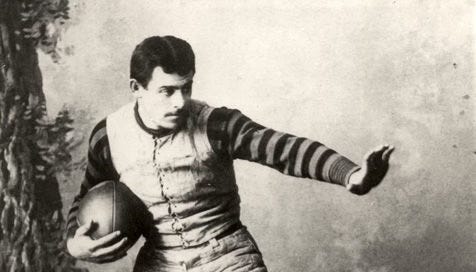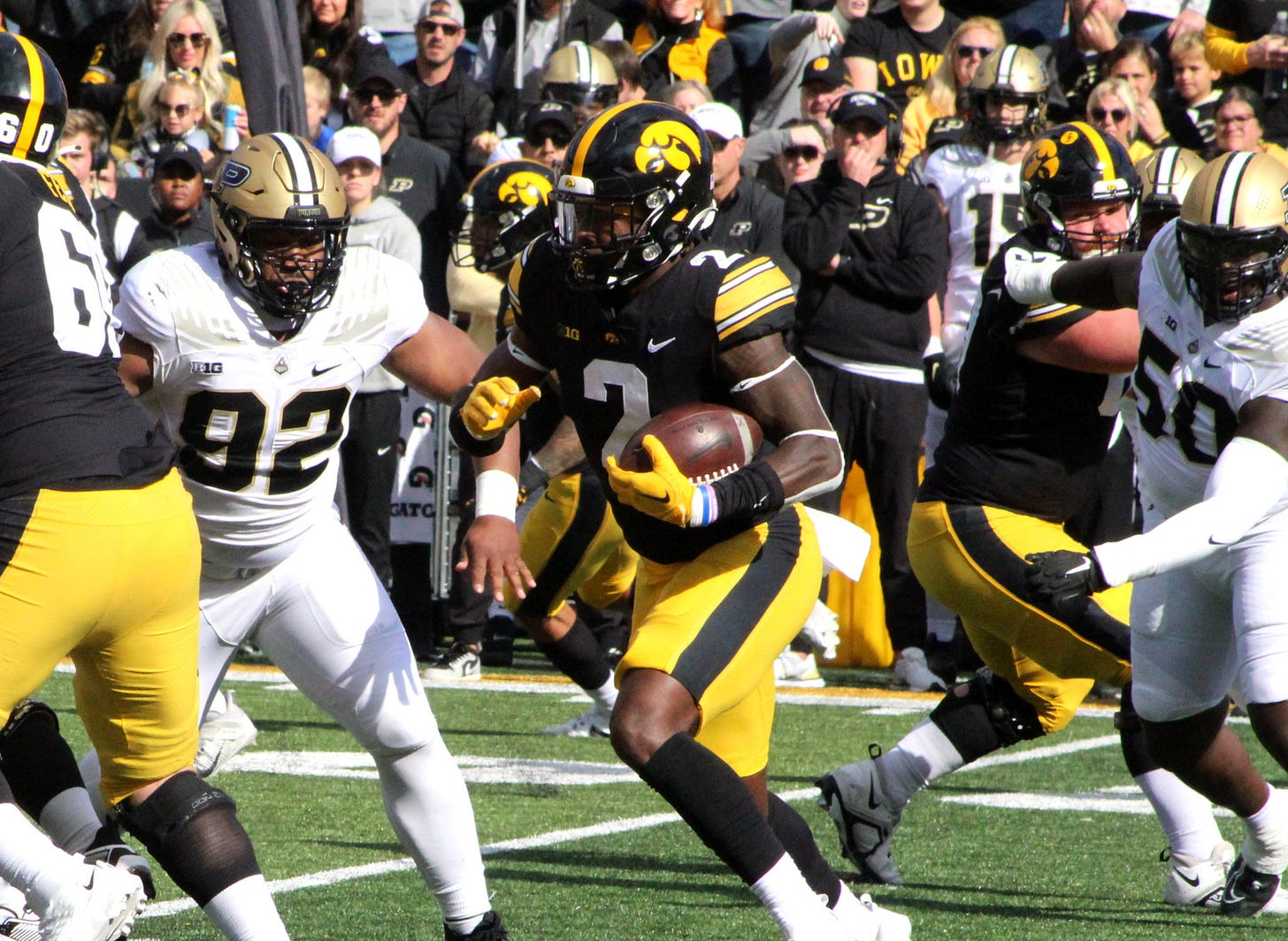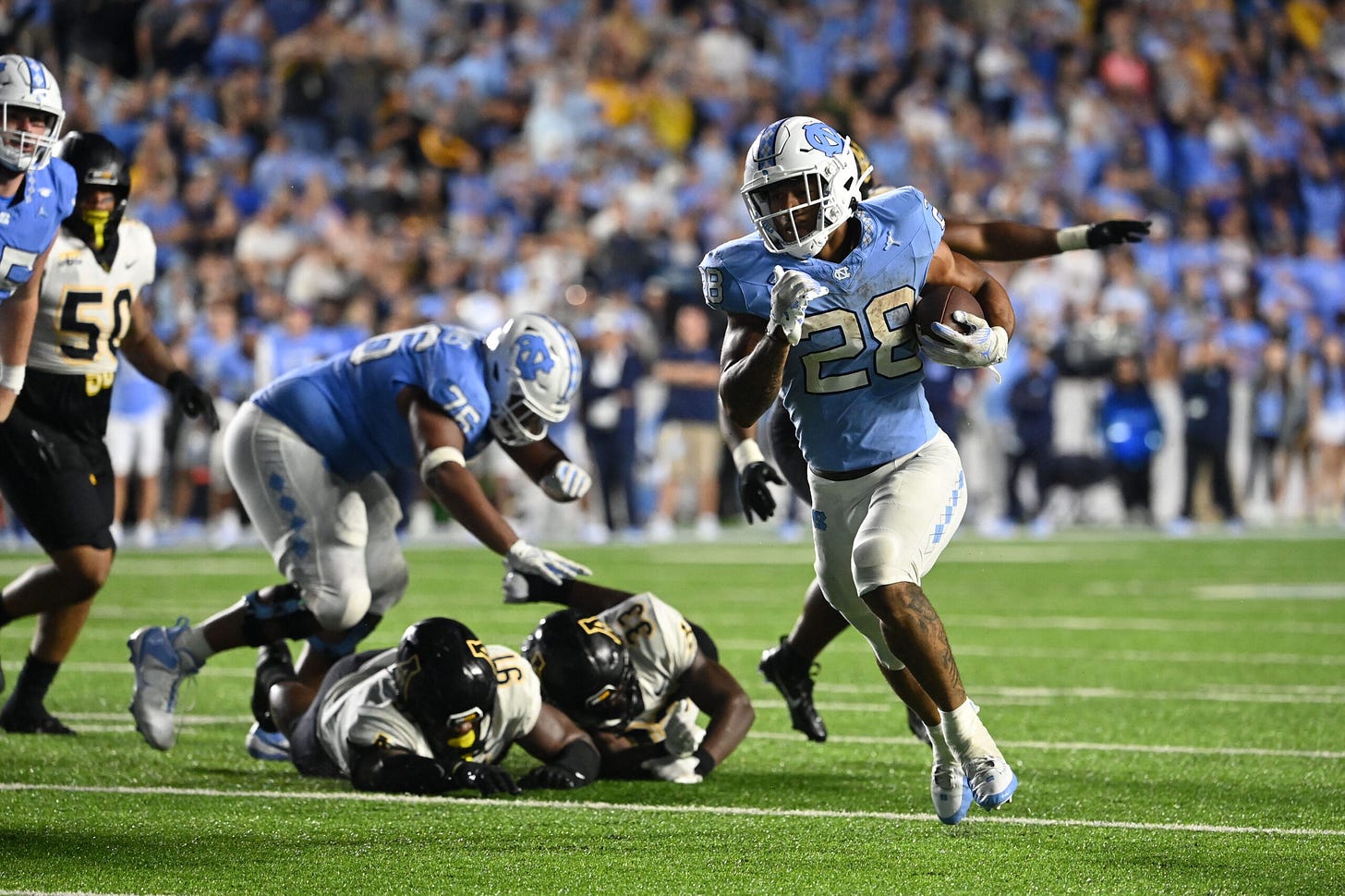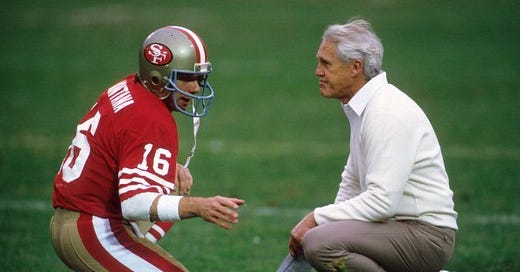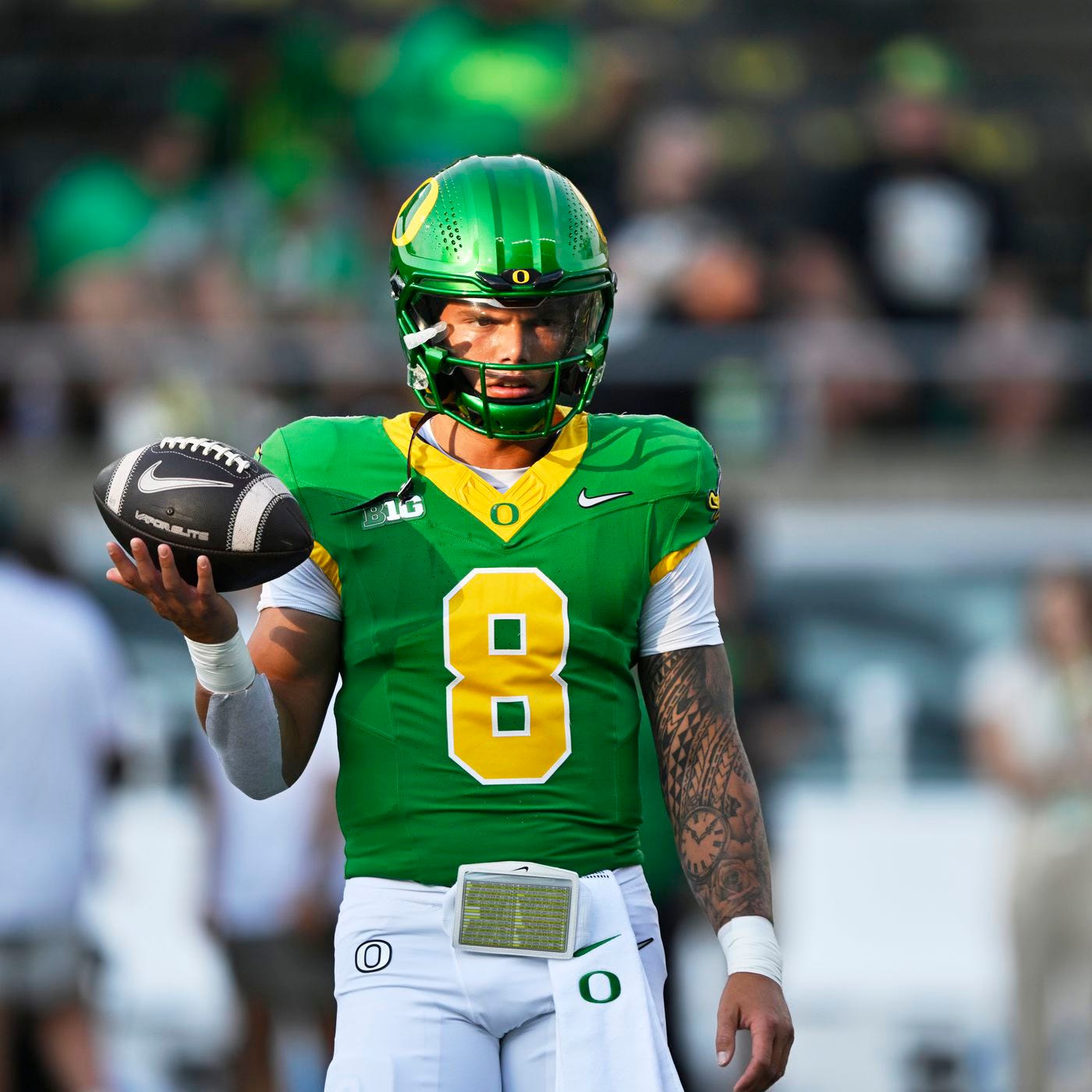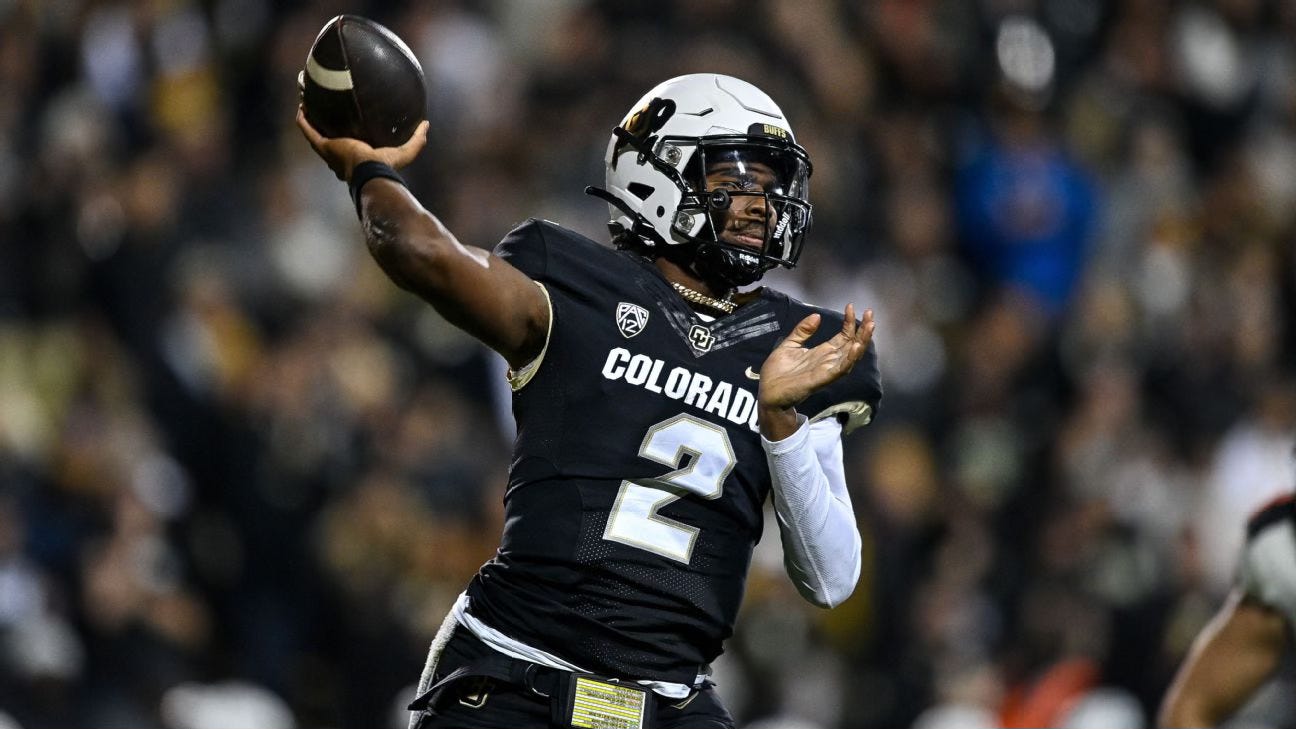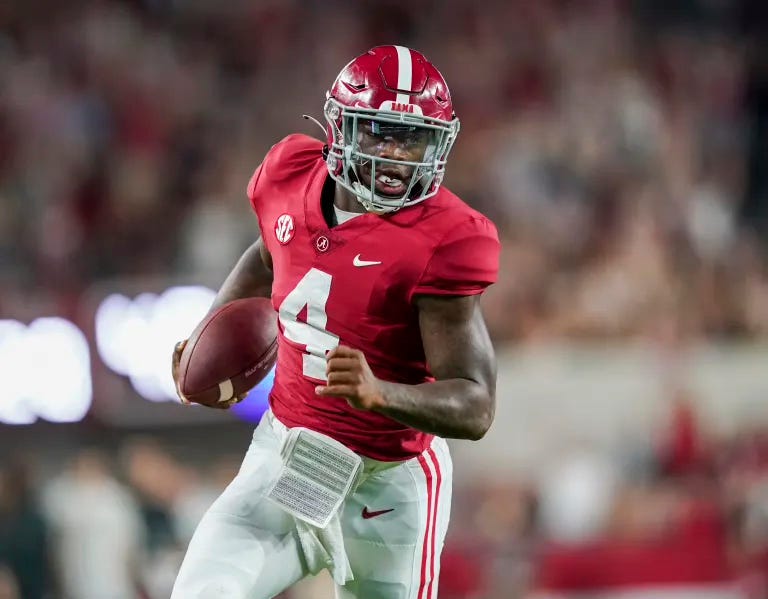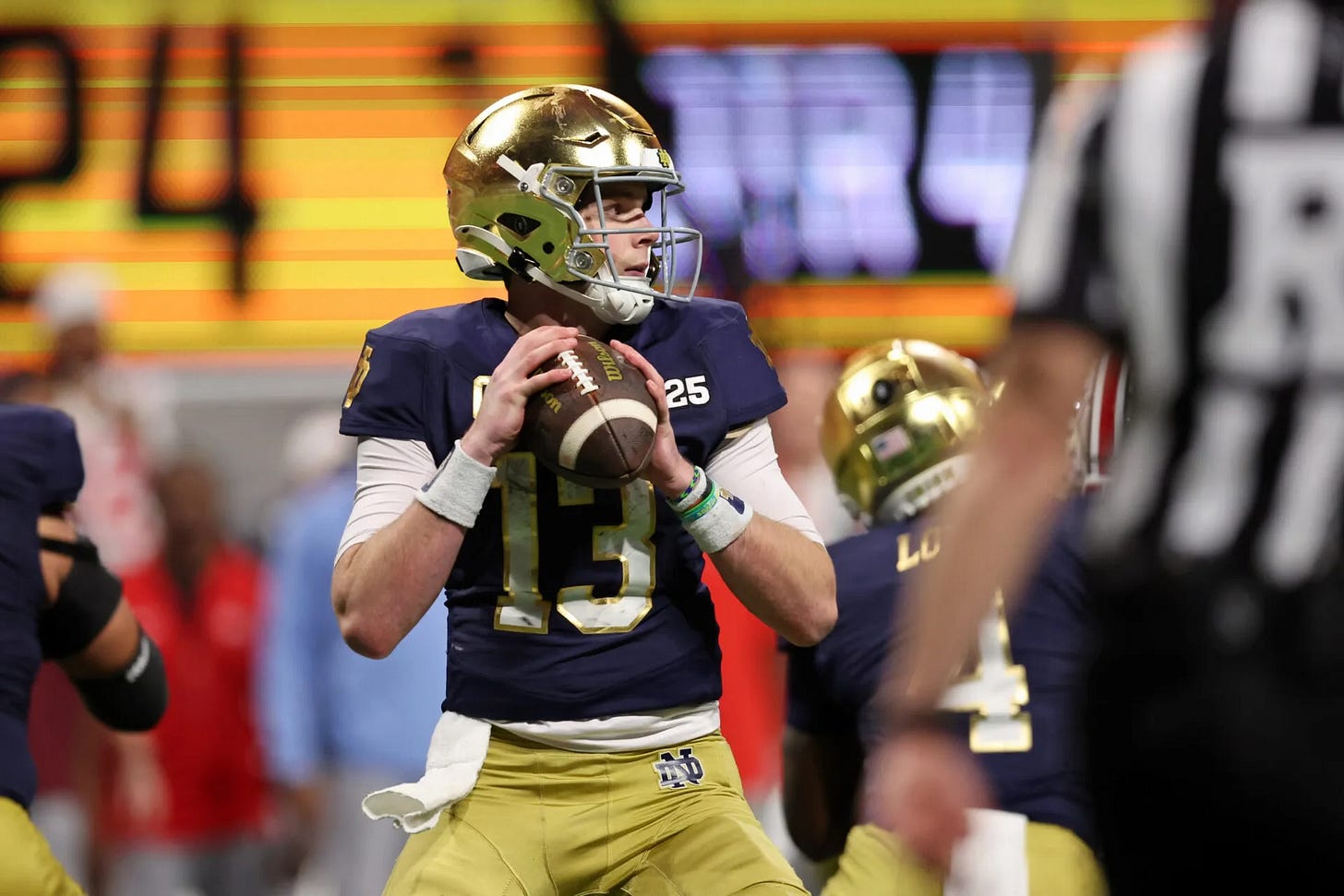The Running Backs
The 2025 Class of Runners is deeper than we've seen in some time - but how do they project to the next level?
“Gentleman, it is better to die a small boy than to fumble this football.”
- John Heisman
Running backs once dominated the NFL landscape, thriving in an era when offenses operated primarily under center. However, the advent of the spread offense, popularized by Art Briles at Baylor and its subsequent evolution through the college ranks, has catalyzed the reshaping of the position's role at all levels. The modern offensive philosophy emphasizes attacking and exploiting defensive space with playmakers to generate explosive plays. Running backs, who were once the focal point of delivering continuous "jabs" to the defense, now find their contributions frequently replaced by "long handoffs" in the form of quick passes to the flat and sideline as a wrinkle for drawing the defense to the line of scrimmage and spreading them out. These horizontal attacks have the added potential to exploit weaker tackling by less physically imposing defenders, allowing for the potential of explosive plays to be made and it’s been the running back who has borne the cost of this adjustment in philosophy.
The Running Back Eclipse & The Next-Gen Shift
In 2024, the NFL showcased a resurgence of commitment to the run game that requires tracking all of the way back to 2010 in order to find a season that exceeded it - although 2012 came close. As defenses adapted to counter high-powered passing attacks from the likes of Patrick Mahomes and Josh Allen with two-high safety looks and Cover 6 schemes, offenses found their counterpunch in the run game. 2024 saw six backs get +300 carries, Saquon Barkley (345), Derrick Henry (325), Kyren Williams (316), Bijan Robinson (304), Jonathan Taylor (303), and Josh Jacobs (301). Let’s go backwards down the number line to understand the significance,
2023 saw no running backs eclipse 300 carries.
2022 had three.
2021, 2020, and 2019 each had two.
2018, 2017, 2016, and 2015 all had only one.
2014 and 2013 each had two.
2012 compares with five.
2011 had two.
2010 had seven with Maurice Jones-Drew carrying it 299 times for nearly eight.
2009 had six.
2008 had five.
2007 had six
2006, 2005 had ten while Larry Johnson carried it 416 times in 2006 (!).
2004 had nine.
2003 had thirteen.
2002 had nine.
2001 and 2000 had ten.
In summary, we’ve just lived through a nearly two decade era in the NFL that I call the Running Back Eclipse - the devaluation of running backs in the draft and in contract negotiations, resulting in the decline of feature backs in favor of a running back committee as a supporting cast to the passing game. The Running Back Eclipse emanates from unique forces - the leagues never ending project of tuning it’s aerial elements, the rise and dissemination of the Spread Offense and Air Raid concepts in the early 2010’s, and the simultaneous renaissance that I refer to as the Next-Gen Shift - the rise of analytics.
As football teams built out whole departments staffed with wonks and math nerds, the very language we use to describe football changed and so too did the way that we think about it. The emphasis on analytics was a mutual embrace of passing being more efficient than running. The rise of data-driven decision making wasn’t limited to running vs passing the ball on a given down and distance, or going for it on 4th down, or all of the other ways that we have seen the Next-Gen Shift manifest, but also in the type of athletes that roster construction valued.
Is 2024 a blip like 2012? My assessment is that it is not - football is in a constant state of revolution. I believe 2024 showed that a shift towards recommitting to the run game is brewing as the necessary force to put defenses back onto their heels and force their thought leaders into the cycle of “shit, what next?”
Running Back Evaluation Framework
The Anatomy of a Carry
Each running back has a unique skill set - to effectively assess a running back’s potential, my evaluation divides a carry into two critical phases: The First Four Yards and The Second Level.
The First Four Yards
This phase focuses on what happens behind the line of scrimmage and through the blocking front. Key skills include:
Pressing the Line: Running backs must press up to the wall of linemen at the line of scrimmage with a low pad level to gain leverage over defenders. Pressing the line creates deception and throws off the lines of sight for the defense, obfuscating angles of pursuit. For example, Le’Veon Bell played at 6’1” 225 but excelled at deception by pressing the line with a low pad level before exploding through the blocking scheme. He struck an effective balance between accelerating through space and deceiving defenders.
Momentum is Key: Maintaining or building momentum through the blocking front, where unpredictability is highest, is critical for effective running. The runner should accelerate when possible to avoid becoming a sitting duck for tacklers. Behind the blocking front, the runner should prioritize speed cuts, pressure steps, and movements that either preserve or build speed. We don’t want to see backs freezing in the hole or opting for jump cuts.
Vision and Footwork: After pressing up to the line, the ability to identify creases in the blocking scheme and accelerate through them is paramount. Precision footwork synchronizes the running back’s timing with the offensive line, creating seamless execution, and prevents them from anchoring down in a spot. Footwork serves as the silent metronome that guides offensive football, dictating timing in the run game just as it does in the passing.
Ball Security: From snap to whistle, proper ball handling is non-negotiable - I’m a tough grader when it comes to it. The ball should be pulled tight to the sternum, with the carrying arm’s wrist above the elbow, holding the ball tightly under the chin and that same elbow tight to the abdomen. Locking the ball carrying wrist with the free hand provides ideal security through unavoidable contact.
The Second Level
In open space, the runner’s instincts and feel for the play come into greater importance. Success here requires:
Attacking Leverage: Effective backs attack a defender’s leverage to not only maximize yards gained via forward momentum, but also to reduce injury risk. By bisecting a defender and targeting one-half of their body, the back can lock the wrist, lower their pad level, and drive through the half-defender with their full body, lifting the tackler's center of gravity and maintaining forward momentum.
Efficient Use of Moves: A back’s arsenal of separation moves may be limited or expansive, but must be executed with precise footwork while maintaining balance and momentum. Some prospects can seamlessly stack and string multiple moves together, accelerating to full speed quickly. These prospects aren’t guaranteed to grade out better than a more “limited” prospect in that regard as we’re evaluating the repeated capacity for maximizing productive yardage on every carry. Some athletically gifted prospects lower their own ceiling and lose the trust of their coach by compromising execution within the framework of the play by freelancing and embellishing on carries.
Contact Balance: The ability to run through arm tackles and maintain momentum is a hallmark of elite running backs. Hip fluidity and quick feet - akin to the skills of a dancer - allow backs to navigate the chaos of the blocking front and secondary while maintaining balance. Jahmyr Gibbs is far from a power back but displayed exceptional contact balance at Alabama.
Durability and Maturity
Understanding how to combine power with finesse is crucial for longevity. James Conner, at 6’1” and 233 pounds, learned to temper his physicality in order to preserve his body after durability concerns had put his career up against the ropes. Similarly, Derrick Henry’s strategic running style has enabled him to sustain a high level of play over an extended period with exceptional durability.
Additional Considerations
To be a complete back, a player must excel in all phases of the game. His role as a receiver and pass protector are also factored into the final grade:
Receiving Ability: Modern running backs are often required to line up as wide receivers and contribute in the passing game. Their ability to force mismatches and dictate defensive personnel is a valuable asset in today’s positionless football.
Pass Protection: Protecting the quarterback is a vital skill. Effective pass blockers use pad level, feet and hip positioning, and a blend of finesse and power to buy their quarterback time. Vision and awareness are essential to anticipate blitzes and pick up unblocked defenders.
Conclusion
The modern running back must possess a versatile skill set to thrive in today’s NFL. Whether it’s running, catching, or blocking, their ability to contribute on every down determines their role. A back who excels in one area may find a place in a committee, but a player who master’s all three can become a true lead back. This framework informs my approach to evaluating the position.
The 2025 Running Backs
Tier 1A - Immediate Hero
RB1 - Ashton Jeanty, Boise State Broncos
Overall Grade A+
The First Four Yards A+
The Second Level A+
Athleticism A+
Receiving A+
Pass Protection C-
There’s a genre of video game known as Horde Shooter; essentially, the player has to sustain waves and waves of enemies to survive longer than they’ve ever had. When we consider NFL defenses and the relentless waves with which defenders attack the ball carrier, I think of a player like Saquon Barkley as ‘Player 1’ in a metaphorical Horde Shooter; someone who defies the problems of what isn’t blocked and finds answers while calculating solutions one-to-two moves out. Ashton Jeanty won’t jump and twirl and spin and hurdle like Saquon, but Ashton Jeanty is Player 1 - understanding moves one-to-two problems down stream of the one he’s currently solving. Every run is a vision quest - Jeanty is the complete back in this draft class, combining elite vision, contact balance, and playmaking ability with an uncompromising effort on every touch. His ability to change direction with immediacy and accelerate through traffic foists accountability upon all 11 defenders; although he doesn’t have homerun speed, he can challenge their pursuit angles and keep the run alive with contact balance.
Beyond his running ability, Jeanty flashes soft hands as a pass-catcher, having had to secure some difficult throws and quickly transitioning into a runner - making lemonade out of lemons. Compared to Bijan Robinson - who was a smooth runner and fluid mover - Jeanty brings a much harder-nosed, blue-collar style and is a more difficult tackle to make. Bijan didn’t have the level of vision and capacity that Jeanty does for keeping a play alive despite so many defenders getting contact on him.
Strengths
✅ Elite Contact Balance – Absorbs hits without losing momentum on redirect and consistently breaks through arm tackles.
✅ Outstanding Vision – Instinctively finds cutback lanes and makes split-second adjustments to maximize yardage.
✅ Effort & Physicality – Relentless on every carry, often dragging defenders for extra yards.
✅ Receiving Upside – Soft hands and a natural transition from receiver to ball carrier; capable of turning broken plays into positive gains.
✅ Workhorse Durability – Has proven he can handle a heavy workload without wearing down.
Areas for Growth:
⚠️ Lacks Elite Breakaway Speed – Won’t consistently run away from NFL defensive backs in the open field - but they can’t tackle him.
⚠️ Limited Pass-Blocking Reps – Effort is there, but he needs refinement in technique and recognition.
⚠️ Receiving Volume – His pass-catching ability is strong; he just hasn’t been featured extensively as a receiving threat.
Tier 1C - Anti-Hero
RB2 - Jaydon Blue, Texas Longhorns
Overall Grade A-
The First Four Yards A
The Second Level B
Athleticism A+
Receiving A-
Pass Protection A+
Jaydon Blue is a versatile, explosive back who emerged as a key playmaker for Texas in his final season where he showcased his dual-threat ability as both a runner and receiver. While he is likely not being thought of as an every down back for the next level, I contend that his excellent patience and vision between the tackles, paired with his receiving prowess and high end athleticism make him the second best prospect in this class and an heir apparent to an NFL backfield. Blue presses the line, has excellent patience for blocks to set up, and gets vertical with reflexive burst. He racked up 146 yards and two touchdowns in a standout College Football Playoff performance against Clemson, including a 77-yard game-breaking score, and became the first Longhorn since Bijan Robinson to tally four total touchdowns in a single game (vs. ULM).
Blue is not a one trick pony, or a satellite typecast - in pass protection, he willingly engages blitzing defenders with good technique and strength to buy his QB time and shows no lack of courage or panic when one-on-one with a DE or LB. Matched with his feel for running between the tackles and his well-advertised receiving ability, he has proficiency in all three key areas that are enhanced by his athleticism and can be a productive lead runner out of the gate for the right team.
Strengths:
✅ Smooth, Patient Runner – Manipulates defenders with subtle movements, presses the line effectively, and creates lanes.
✅ Explosive Playmaker – Has the agility and acceleration to turn small openings into big gains.
✅ Strong Receiving Ability – Dangerous out of the backfield, showcased in the Ohio State playoff game.
✅ Good Contact Balance – Not a power back but consistently finds ways to absorb contact and keep moving.
✅ Pass Protection Effort & Technique – Engages blitzers well for his size, showing technique and willingness.
✅ Understands How to Preserve His Body – Knows when to split defenders or take smart contact to minimize punishment.
Areas for Growth:
⚠️ Ball Security Concerns – Needs to secure the ball better through traffic and contact to avoid turnovers.
⚠️ Lacks True Power Back Traits – While he has solid contact balance, he’s not a bulldozer and won’t always push the pile.
⚠️ Limited Feature-Back Workload – Hasn't been relied upon as a full-season workhorse, leaving some durability questions.
Tier 2A - Legion Backs
RB3 - Bhayshul Tuten, Virginia Tech Hokies
Overall Grade B+
The First Four Yards C+
The Second Level A
Athleticism A
Receiving A+
Pass Protection C+
Bhayshul Tuten is a dynamic, versatile playmaker with undeniable homerun ability every time he touches the football. A transfer from North Carolina A&T, he was Virginia Tech’s top offensive weapon in 2024 while playing most of the season with a cumbersome knee brace - highlighted by a record-setting 266-yard, four-touchdown performance against Boston College. Tuten is built for the part and has great speed, burst, with excellent contact balance, making him dangerous in space and consistently reliable through contact. He’s a fluid pass-catcher with the toughness to contribute in pass protection, and his experience as a return specialist only adds to his NFL versatility. Even while playing through injuries in 2024, he remained one of the most explosive backs in the ACC.
Tuten’s ball security, however, and particularly through traffic, is careless when he opens up his stride. He prefers to carry the ball along his forearm, swinging free from his body with his stride, which cost him a fumble on a heroic run vs Rutgers where he displayed NFL prospect speed, vision, and contact balance all for the ball to be carelessly poked out at the end, a shattering betrayal. Tuten also occasionally misreads blocking fronts, which limits his efficiency between the tackles. Still, his speed, play strength, and ability to generate big plays in all phases make him one of the most exciting backs in this draft class. With some improvements, he projects as a dangerous weapon in a gap-based system and could grow into a feature role as a lethal zone runner if he cleans up these details.
Strengths:
✅ Explosive Speed & Quickness – Among the fastest backs in this class; accelerates instantly and creates separation in the open field.
✅ Excellent Contact Balance – Stays on his feet through both direct and indirect tacklers, making him difficult to bring down.
✅ Versatility – Proven ability as a runner, receiver, and return specialist; contributes in multiple phases of the game.
✅ Toughness & Durability – Played through knee and ankle injuries and still produced at a high level.
✅ Receiving Ability – A reliable target out of the backfield with good hands and strong playmaking ability after the catch.
✅ Pass Protection – Sound and effective, even if not elite; shows good technique and awareness in blitz pickup.
Areas for Growth:
⚠️ Ball Security Issues – Prefers to carry the ball along his forearm, often letting it swing away from his body, leading to costly fumbles (e.g., vs. Rutgers).
⚠️ Occasional Misreads in Blocking Fronts – Sometimes fails to properly read and react to blocking schemes, limiting his ability to maximize runs.
⚠️ Lacks Elite Power – While strong for his size, he’s not a punishing, between-the-tackles bruiser.
RB4 - Kaleb Johnson, Iowa Hawkeyes
Overall Grade B+
The First Four Yards B+
The Second Level A+
Athleticism A-
Receiving B-
Pass Protection D+
Kaleb Johnson is a big-bodied record-setting back for Iowa, finishing his career sixth in program history in rushing yards (2,779), fourth in rushing touchdowns (30), and sixth in total touchdowns (32). His ability to hit top speed quickly, combined with strong contact balance and vision between the tackles allows him to break off chunk gains in addition to churning out the tough yards inside.
Johnson is at his best when running downhill, showing good patience in zone schemes and excellent burst in gap concepts. He runs light on his feet, properly reads leverage, and demonstrates good frame manipulation which makes him a versatile back who can succeed in multiple run schemes. While he benefited from Iowa’s strong offensive line play, his game against Wisconsin in particular showcased his ability to create yards beyond what’s blocked.
In the passing game, his hands are fine but largely untested, meaning his role as a receiving threat remains unclear. His ball security shows better awareness in the second level than some reps through the hole and his pass protection is at-standard for cleaning up the blitz.
His tall, lean, quick style of running remind me of Brian Robinson Jr - a back that not many people thought highly of when he came out due to “athletic limitations” but whose game showed a smart, decisive runner between the tackles, whose nimbleness and subtle creativity have made into an NFL lead committee back.
Strengths:
✅ Quick Burst & Acceleration – Gets downhill fast after the snap and reaches top speed quickly, making him a home-run threat from anywhere.
✅ Contact Balance & Strength – Runs through arm tackles and maintains balance in traffic, bouncing off defendersrather than going down on first contact.
✅ Patience & Vision – While he thrives in gap schemes, he’s shown good patience to let blocks develop in zone concepts. He reads leverage well and adjusts accordingly.
✅ Big-Play Ability – 21 runs of 20+ yards in 2024, including multiple 40+ yard touchdowns. He doesn’t need a wide-open lane to create explosive plays.
✅ Ball Security – No glaring fumbling issues; keeps the ball tight through contact.
Areas for Growth:
⚠️ Receiving Ability is an Unknown – Limited receiving production (22 catches for 188 yards in 2024), so it’s hard to gauge his route-running and natural hands.
⚠️ Pass Protection Needs Refinement – Willing blocker but needs better technique to handle NFL pass rushers effectively.
⚠️ Benefited from Strong O-Line Play – Iowa’s offensive line gave him clear running lanes, but his ability to create when the blocking breaks down at the NFL level is something to watch.
⚠️ Needs to Adjust to NFL Speed – He can succeed in a zone-heavy scheme, but the faster decision-making required at the next level will be an adjustment.
RB5 - Omarion Hampton, North Carolina Tar Heels
Overall Grade B+
The First Four Yards A+
The Second Level A
Athleticism C+
Receiving A
Pass Protection F
Omarion Hampton is a powerful, one-cut runner with a blend of physicality and agility that conjures memories of DeMarco Murray. At 6’0”, 220 pounds, he possesses a strong yet lean frame, making him an ideal fit for a gap-heavy rushing scheme. Hampton’s ability to get skinny through creases, maintain a low pad level, and finish through contact were relentlessly impressive on runs between the tackles.
A two-time 1,000-yard rusher at North Carolina, Hampton finished among the FBS leaders in rushing yards per game and yards after contact in 2023, earning Doak Walker Award finalist honors. While he lacks true breakaway speed, his short-area explosiveness, hurdling ability, and natural receiving skills make him a versatile backfield threat. With continued development in pass protection and some added creative juice to create extra yards in the open field, he has all the raw materials of a lead back.
Strengths:
✅ Powerful, One-Cut Running Style – Wastes no movement, plants his foot, and accelerates decisively through lanes.
✅ Short-Area Burst – Explosive in confined spaces; can hurdle defenders and create separation in traffic.
✅ Contact Balance & Toughness – Absorbs hits and churns out extra yardage, making him a grind-it-out back in tough situations.
✅ Ball Security – Carries the ball high and tight, limiting turnover risk.
✅ Versatility – Flashes natural receiving ability, allowing him to contribute beyond just rushing downs.
Areas for Growth:
⚠️ Lacks Elite Top-End Speed – Not a true home-run hitter in the open field; long runs can get tracked down.
⚠️ Pass Protection Development – Shows effort but needs improved technique and recognition to be a reliable third-down back.
⚠️ Needs to Develop More Creativity – Can be too linear in his approach; doesn’t always manipulate defenders with subtle cuts or fakes.
I scouted 22 running back prospects for the 2025 Draft. If you are interested in reading more about this class, please like and share this post with one friend. Then, leave a comment below - if we can add to my subscriber count, I’ll share Part II. Cheers!




